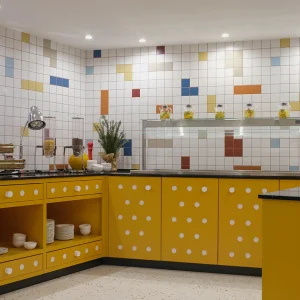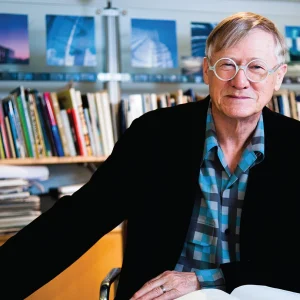
These are turbulent times for retailers. The worst recession in British history coupled with the rise of online shopping is changing the face of the British high street. In an age when we’re a mouse-click away from buying almost anything online, retailers are being forced to work harder than ever to make shopping a desirable experience – and that’s where Gregor Jackson comes in.
The nattily dressed Scotsman, who founded retail design and branding consultancy gpstudio in 2004, has made it his business to stay ahead of the curve, and he specialises in translating brands such as Harrods, Mulberry and the Victoria and Albert Museum into retail spaces that make shopping an desirable experience.
‘To succeed, retailers have to create a real experience and an extension of their brand,’ says Jackson. It’s a process he describes as ‘brand architecture’ and it begins, he says, with thorough research.
‘You’ve got to get inside the client’s world, which involves research and understanding their market before you even meet them,’ says Jackson, who employs a dedicated researcher and trend forecaster as well as encouraging the whole team of 18 to find out everything they can about the client they’re working with.
‘Often in that first meeting a client can be quite guarded so it helps to be able to show that you know their world and you’ve taken the time to find out about what concerns they have and what problems they might be facing.’
So involved does gpstudio become with each client that Jackson says it is often considered one of the team. ‘It’s about getting to the stage where the client is so comfortable that we are almost seen as like a non-executive extension, part of the team, so they can share that information and we can totally understand where they want to be in 12 months, three years, 10 years. Then we start to work with them on what the brief is.’
But representing existing brands is only part of what gpstudio does. Often clients approach Jackson and his team because they want to change the way they, or their product, is perceived. One example of this was The Whisky Shop, which wanted to expand in London and asked gpstudio to design its new flagship store in Piccadilly.
‘They were really keen to tear up the rule book and look at a new way of presenting whisky,’ says Jackson. ‘And, as is often the case with clients, at first they knew more about what they didn’t want than what they did want.’ The owners of The Whisky Shop were keen to avoid the look and feel of an off-licence or bottle shop so Jackson and his team encouraged them to look in some surprising places for inspiration.
‘We had a series of workshop meetings with The Whisky Shop to get them thinking about different brands. We talked about Apple, for example, and what made the Apple Stores so inviting and accessible. There’s a sense of "come in and touch and play", and the advice and the service you get is excellent. There were lots of aspects of that brand experience that we thought were interesting. We also looked at [fragrance brand] Jo Malone – viewing how a fragrance brand would present its products, to see if we could do something similar with whisky.’
The Whisky Shop store feels more relaxed, informal and welcoming than you might expect from a shop selling whisky. There are interactive displays from which visitors can learn about the product, and window displays that draw on some recent commercial partnerships between, for example, Scotch brand Chivas Regal and men’s shoe designer Tim Little.
‘We didn’t want the window display to be the traditional tartan blanket crammed with bottles,’ says Jackson, ‘so we treated it in the way that any shop on Bond Street might treat its window. It’s something that should stop you and catch your attention,’ Jackson says. There’s also an area where people can sample the whiskies and learn more about them – an idea inspired by the Apple Stores.
Jackson studied interior design in Edinburgh before moving to London where he first worked for Design Solution before helping to set up design consultancy Four IV, which he helped run for nearly 13 years before setting up gpstudio. The aim with gpstudio, he says, has always been to keep it ‘a small to medium-size design consultancy where we can really deliver beyond the brief and beyond the client’s expectations’.
Looking at the practice’s client list since then, I get the impression that expectations must be pretty high. Take the Qatari royal family, for example, which asked gpstudio to design a space in Harrods called In-Q that would ‘reflect the cultural essence of Qatar’.
‘In a sense we were branding a country,’ says Jackson. ‘They really wanted something that reflected their culture and represented them, correctly, as a country that’s very forward-thinking and impressive.’
The finished scheme is part shop, part cultural centre, a place to learn about Arabic culture through a selection of traditional arts and crafts, books, clothes and jewellery, and merchandise from Qatar’s museums and galleries. The hexagon – a major Arabic pattern that is also familiar in the West – works as a motif to draw the two cultures together, while white walls are covered in tadelakt, a plaster finish used widely in the Middle East and North Africa.
There has been much talk lately of the decline of the British high street, but research by data company Kantar found that of the £311bn spent in the UK on shopping last year 90 per cent was spent in brick-and-mortar shops and stores. And while the role of the internet seems likely to grow further, Jackson says there will always be a place for physical retail space: ‘While people are happy to buy things such as books and DVDs online or even in digital formats, there is some shopping that is quite complex and emotional. There are still lots of products that people want to touch or try on before they buy.’





